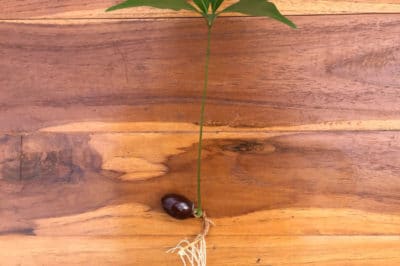Disadvantages of Seed-Grown Trees
As with a large majority of fruit trees propagated through planting seeds, including lychee, there always seems to be more disadvantages than advantages. Many times, these disadvantages deal with the genetics of the seedling and the eventual fruit it bears.
Due to hybridization, growing a lychee tree from seed doesn’t mean you can expect the same quality of the fruit like fruit from where you gathered the seed. The seed-grown tree could produce fruit of the same quality, a better quality, or lower quality.
For this reason, commercially, seed-grown lychee trees are primarily grown for use in breeding or as rootstocks.
Other basic disadvantages to growing a lychee tree from seed for the fruit includes:
- Although seeds may look healthy, lychees are known not to always reproduce faithfully from planting seeds. Therefore, you will probably need to plant several seeds to increase the possibility of germination.
- It’s necessary to propagate fresh lychee seeds, as they lose their viability after four or five days.
- It can take a seed-grown lychee tree as long as 25 years before it produces its first crop, whereas grafted trees start producing after about three years.
Taking a Chance
Despite all the possible disadvantages, you are feeling lucky and want to take a gamble and plant and grow a lychee from seed. Like the old saying goes “You’ll never know unless you try it,” planting and growing your lychee from seed is relatively basic and who knows, you might end up with delicious fruit.
- Select fresh, clean seeds, as they have the best chance of germination. Clean off any fruit still attached to the seed.
- Fill a 6-inch container with a well-drained potting mix. Water the soil to settle it before planting the lychee seed.
- Plant the seed in the center of the container, planting it about 3/4 inch deep and cover with soil.
- Water the container again.
- Situate the container indoors in a sunny window or outdoors in a warm, sunny location.
- Water when the top inch of soil feels dry and the lychee seed should germinate in about a week.
Expert Tip: It’s not necessary to fertilize your lychee seedling for the first year. Once the seedling begins to outgrow its container, repot into a 1- or 3-gallon container so it doesn’t become root bound.
Growing Requirements
Lychee trees are hardy in the subtropical climates of USDA zones 10 through 11. They will grow in the warmest areas of zone 9, as long it’s protected during unexpected freezes during winter. The tree works well used as a screen or hedge and grows well in containers.
Plant the lychee tree in a sunny location where strong winds aren’t a problem, and in fertile soil that drains well. The tree has a moderate tolerance to drought, so weekly water applications produce the best growth, flowering and production of fruit
